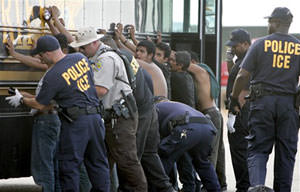America’s ICE Backwards Approach to Immigration
While the nation’s understaffed immigration courts strain under a backlog that has grown to more than 200,000 cases, thousands of new border agents have been hired and the number of government attorneys who argue for deportation has increased by 35 percent, pushing more cases onto an already overburdened system.
By Andrew Becker and Hugo Cabrera, CIRThis article is a collaboration with the Center for Investigative Reporting.
While the nation’s understaffed immigration courts strain under a backlog that has grown to more than 200,000 cases, thousands of new border agents have been hired and the number of government attorneys who argue for deportation has increased by 35 percent, pushing more cases onto an already overburdened system.
As a result, cases often take months if not years to complete, leading to more immigrants being held in a growing network of detention facilities and jails. On any given day there are more than 30,000 people in immigration lockup.
Since 2004, 184 trial attorneys have been added by Immigration and Customs Enforcement (ICE), bringing the number of lawyers to about 709 as of Feb. 18, according to records recently obtained by the Center for Investigative Reporting through a Freedom of Information Act request. ICE, a bureau of the Department of Homeland Security (DHS), arrests and detains persons suspected of being undocumented immigrants and deports those ordered removed from the country by an immigration judge.
The hiring of more border agents also contrasts sharply with the hiring of immigration judges who have struggled to keep up with the case backlog. While nearly 5,000 border agents were hired from 2006 to 2008—the number of Border Patrol agents is expected to reach 20,000 this year—there has been a net increase of only three judges from 2006 to June 26, 2009. The number of judges has fluctuated, mostly as a result of retirement, and now stands at 233 jurists, according to the Executive Office for Immigration Review (EOIR), the Justice Department agency that oversees the nation’s 57 immigration courts.
The shortfall of judges has contributed to a backlog of cases that reached 201,212 as of April 30, a 19 percent increase since 2006, according to a recent report by Transactional Records Access Clearinghouse (TRAC), a nonpartisan data-analysis group at Syracuse University. The backlog has jumped 64 percent since a decade ago.
Of the 233 current judges, all but a handful regularly hear cases, which TRAC estimates will exceed 384,000 this year, up from about 354,000 cases last year. Looking at one week last year, TRAC found that each judge normally handled about 69 cases in that single week.
“For some people, these are the equivalent of death penalty cases, and we are conducting these cases in a traffic court setting,” Judge Dana Leigh Marks, the president of the National Association of Immigration Judges, recently told National Public Radio.
The Justice Department has been slow to hire much needed immigration judges, the TRAC report states, despite calls by then-Attorney General Alberto Gonzales to add jurists as far back as 2006.
In the Justice Department’s 2009 congressional budget submission, officials underscored that because the immigration courts get most of their cases from the Department of Homeland Security, “The importance of effectively planning and coordinating with DHS, as their enforcement increases, cannot be overstated.”
The Justice Department projects “that the current and planned expansion of DHS enforcement efforts, e.g., detention bed spaces, criminal alien programs and border enforcement, will increase immigration court case receipts well into the future,” according to the report.
Despite appointing more than a dozen judges in the past six months, including 10 in April, EOIR still had 20 open judge positions as of June 26. The 2009 omnibus bill signed earlier this year by President Obama included $5 million for the hiring of new judges, and EOIR requested funding for 28 more for fiscal year 2010, according to the Justice Department.
Meanwhile, ICE documents show that approval has been given to the bureau this year to employ 916 attorneys, of which 735 will argue in courts, and a support staff of 630. As of Feb. 18, there were 26 unfilled attorney jobs. In 2007 the U.S. Government Accountability Office reported that ICE had budgetary approval to employ about 700 attorneys in fiscal year 2006.
Will the new hiring be enough to meet caseload demands as ICE marches more immigrants into court? EOIR thinks so: It checked off as completed necessary budget increases on its 22-point reform to-do list. On average, roughly four judges now share one law clerk, TRAC found. Along with their usual tasks of hearing deportation, asylum and other such cases, judges also handle administrative duties normally done by clerks or bailiffs—duties such as operating digital recording devices (when they’re not struggling with decades-old cassette recorders) and handling exhibits.
As the number of cases put before immigration judges has increased, so too has the pressure on them to get through cases quickly. A survey of 96 judges, included in a recent Georgetown Immigration Law Journal article, highlights the effects of having an inadequate number of judges presiding over asylum cases in which decisions can have life-or-death consequences.
When surveyed about the challenges of immigration court, one judge responded: “We are told to keep producing—to get the cases done, without regard for the fact that we have insufficient support staff, insufficient time to deliberate and to complete cases, and outdated equipment.” The nature of cases heard by immigration judges, combined with case overload and long hours, makes the work of judges especially stressful and puts them at particular risk of burnout, the report states. Such burnout can lead to emotional exhaustion and depersonalization, loss of compassion and cynicism.
Judge Denise Slavin, vice president of the National Association of Immigration Judges, told CIR that the problem could be mostly addressed if there were more judges with better resources.
When asked about the courts’ workload, Elaine Komis, a spokeswoman for EOIR, acknowledged that immigration judges continue to face challenging caseloads, but added that they handle them “admirably well.”
“It is important to note that only a relatively low percentage of cases decided by the immigration judges and BIA (Board of Immigration Appeals) members are ever appealed, and of that small number, almost 90 percent are affirmed at the appellate court level nationwide,” she said. “We think this speaks well for the performance of our agency.”
Decisions in sensitive asylum cases have lacked uniformity and have even drawn criticism from appellate courts. The lack of uniformity is not surprising, given the beleaguered immigration courts and judges. However, there have been recent signs of improvement, according to TRAC.
A Department of Justice spokesman recently told The New York Times that the growing backlog of cases highlighted by TRAC “doesn’t mean that courts are overwhelmed or inefficient,” but rather that backlogs are the result of cases becoming more legally complex or unusual.
One immigration judge told surveyors that, while the law has gotten exponentially more complex and time pressures have made work much more grueling, resources such as clerks have all but disappeared.
And the Justice Department’s 2009 congressional budget submission points out that immigration courts failed to meet two of three time-oriented performance goals for 2007, narrowly missing targets “due to a large number of immigration judge vacancies and an increase in the detained caseload.”
The report continues: “EOIR’s adjudication functions are part of the government’s larger immigration and border control programs. As such, EOIR’s ability to adjudicate cases in a timely fashion allows the larger system to operate more efficiently, including the efficient utilization of DHS detention bed spaces.”
As courts become increasingly saddled with work, the need for them to maintain adequate transparency is, more than ever, critical.
A recent article in The Nation on the lack of transparency of some immigration courts points out that although the court’s policy is for hearings to be open, except in certain situations, that’s not always the case. Jacqueline Stevens, a law and society professor at the University of California, Santa Barbara, describes how she was refused entry to immigration court inside two detention facilities in Arizona. The reasons why she was kept out, she argues, had nothing to do with the certain exceptions.
Indeed, immigration courts have some quirky ways. Members of the public and reporters who want to attend hearings are allowed to observe, but, as the Immigration Courts Practice Manual emphasizes, news media are “strongly encouraged” to give the court administrator a heads-up before sitting in on court, whether the hearing is held at a detention center or not.
|
Andrew Becker is a staff reporter at the Center for Investigative Reporting, a nonprofit news organization in Berkeley, Calif. Hugo Cabrera is a CIR researcher. |
Independent journalism is under threat and overshadowed by heavily funded mainstream media.
You can help level the playing field. Become a member.
Your tax-deductible contribution keeps us digging beneath the headlines to give you thought-provoking, investigative reporting and analysis that unearths what's really happening- without compromise.
Give today to support our courageous, independent journalists.






You need to be a supporter to comment.
There are currently no responses to this article.
Be the first to respond.